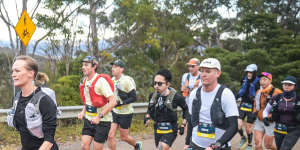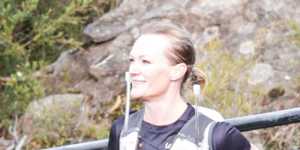The anxious thoughts wobbled around my ability to run the 50-kilometre race,climbing more than 2220 metres of elevation and finishing with 1000 stairs. “Why am I doing this?” I asked myself in private – and in front of anyone who would listen.

The writer on the dirtbag trail:Trail running involves as much walking as running.Sportograf
My best mate answered for me:“To reconnect,to challenge,to carve a thing that’s only yours,to shape-shift,to be masochistic,to prove a thing to self,to manifest disorders into different ones,to get banged up feet,to wipe clean and reboot,to run from and to,to be an athlete.”
Thankfully,when I arrived in the Blue Mountains last weekend,the nerves dissipated and the awe of the natural beauty kicked in.What also kicked in was the realisation that the dirtbag spirit is alive and kicking.
I was one of more than 7000 runners from 48 different countries who came for the four events:the 11,22,50 and 100-kilometre runs.
Just under half the participants were female,and the ages ranged from a 12-year-old (running in the 11-kilometre event) to an 84-year-old (running in the sold-out 50 kilometre event). They had all come seeking the adventure of running through 60 metre-tall eucalyptus forests,down into towering fern gullies,hopping over stones at the base of waterfalls and tracing the lines around rock-faces that are millions of years old. It was spectacular.

The dirtbag spirit pioneers were mavericks who eschewed the trappings of modern life – including permanent shelter,permanent work,the relentless pursuit of “things” and regular showers – for a hardy,spiritually rich life of adventure. Responding to the call of the wild,they lived a humble life,so they could explore its bounty while trail running,hiking and climbing and mountain biking.
There were true dirtbags participating in the Ultra Trail Australia – one guy ran the 100-kilometre trail in bare feet – but I noticed the sport and the spirit are also increasingly being adopted by the rich. The weekend dirtbags,we shall call them.
It’s an expensive pursuit for most people. Entry to the well-run event was $350. Add in a new pair of Hokas (the shoe of choice) for $200 to $250,plus a Salomon hydration vest (the vest of choice) for another $150 to $250.
That’s before you’ve signed up for a training program – a popular one I looked at cost $750;a new outfit (Lululemon was favoured by many women while Nike was a fixture among the men);accommodation in the mountains;physio appointments to help with niggles;sauna and ice bath recovery sessions and any other accessories (Garmin,Apple,Oakleys) people like to look the part of adventure-racing,rich weekend dirtbag (emphasis on therich).
Have we become so comfortable in our lives we are now seeking – and willing to pay big money for – discomfort? The type of discomfort and challenge that is not an option for some people. It’s not a bad thing,in my mind. It takes guts and a spirit of adventure to get off the beaten track of our lives and do something hard.
Plus,I’d venture,it beats the monotony of a road race any day. And,as one seasoned trail runner I spoke with pointed out,it is in some ways more accessible to people who don’t necessarily consider themselves athletes:“You walk the hills and run the flats.”
But,though the weekend dirtbag seeks to explore the wild of mind,body and nature,to test their physical and mental endurance,there are limits to how much some of them really want to rough it. Which explains why luxury ultras have become a trend.

Sarah Berry at the UTA in the Blue Mountains.Sportograf
Entry to the Highland Kings Ultra,a three-day race covering 160 kilometres of “rugged and mountainous terrain” on the west coast of Scotland,costs more than $10,000 per person and includes “luxurious accommodation,sumptuous meals,and rejuvenating massage service” plus a butler to help you when you are wet,cold or sad.
The Last Desert ultra in Antarctica is 250 kilometres across the largest desert in the world and costs more than $20,000 to enter,including transfers on an expedition ship. The Atacama Crossing is also 250 kilometres,but instead of traversing past mountainous icebergs and penguins,participants slog across salt flats,dunes,slot canyons,and river crossings.
It’s comparatively cheap at about $6145.
The famous Marathon Des Sables,which organisers call “the toughest footrace on the planet”,crosses 250 kilometres through the Sahara Desert and is upwards of $8521 to enter.
So why bother? A couple of reasons come to mind.
It’s a way to re-wild ourselves. In ecology, of letting nature take care of itself,“enabling natural processes to repair damaged ecosystem”.
In this case,we are the ones being repaired and,by taking ourselves deep into its beautiful,feral heart,nature does its rhythmic work,restoring something that can get lost in the concrete,comfortable jungle.
And even when we don’t go full dirtbag because we can have a hot shower and a comfortable bed at the end,embracing the dirtbag spirit is appealing.
By seeking out a different view – of ourselves,of our capability,and of our small place in the world – we gain perspective on the rest of our lives and become a little more resilient and adaptable. Weekend dirtbags may not be living on the fringes,and might not be quite as dirty as the purists,but the spirit exists and in the fringes of ourselves,we know there are riches to be found.
Make the most of your health,relationships,fitness and nutrition with our Live Well newsletter. every Monday.